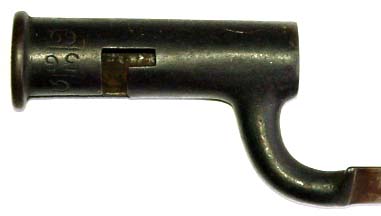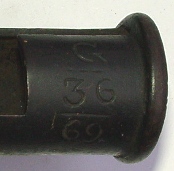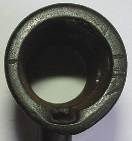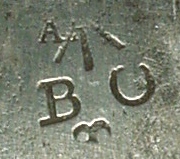.
c.1796-1819 BO India Pattern Bayonet

| OA | 553mm | Bl | 437mm | Sl | 101mm | Mrd | 23.5mm | Sm | 51mm | Bw | 31mm |
The term 'India Pattern' was adopted because the India Pattern Muskets was a development of the current East India Company musket which had a 39" barrel. The adoption of the EIC musket was a direct result of the developments in Europe during the Napoleonic period and the direct threat of war. England had been going through a relative period of peace and arms production had been greatly reduced, the sudden emergency put a great strain on existing Board of Ordnance sources of supply. To overcome this problem the BO diverted supplies of East India Company muskets in production within the trade, in store houses waiting export to India, and even weapons currently on ships bound for Europe. Due to the simplified manufacturing requirements of the EIC musket (mainly in the simplified stock) it was adopted by the BO.



Socket marked with regimentals.

The India Pattern Brown Bess is the most numerous produced British socket bayonet with production estimated at around 3,000,000. Due to the large number produced, the Board of Ordnance had so many in store at the cessation of hostilities that no new bayonets were produced for the BO until the late 1830's.

India pattern bayonets have been noted with the following 'Crown' inspection stamps, i.e.. 'Crown' over a number, 1 (Very few, possibly indicating a Trial of experimental bayonet, as many experimental bayonets in the Tower were inspected by 'Crown' viewer '1'), 3, 4, 5, 6, 8, 19, 29, 31, 40, 41 and 46.
IMPORTANT NOTE A popular opinion among collectors and indeed most reference books is that a 'Crown' viewers mark indicates a Board of Ordnance bayonet. Recent research into the East India Company has revealed that they also used a 'Crown' viewers mark, although they apparently never used a viewers number greater than 10. It is also now known that the EIC company used a 'Crown' over 'P' inspection stamp on the Lawrence pattern bayonet (1760-69) (The Crown 'P' mark my also indicate a Birmingham trade inspection mark) .
India Pattern shoulders are one of the most distinguishing features of this pattern being much more triangular in shape compared to the elliptical shape shoulders of the earlier patterns.
Blade marked with the Board of Ordnance ownership mark, this appears to be a very rare mark, as few bayonets bear it.